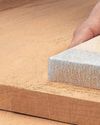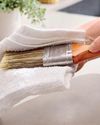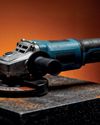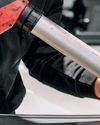WORKING ON THE ROOF? HERE'S HOW TO DO IT SAFELY
The Home Handyman
|May/June 2023
Because it's better to be safe than sorry. While it's not necessarily wise to get up on your roof, there may be times when you need to make the climb to fix a slipped or broken tile or install a skylight, for instance
-

If you want to do your own DIY jobs then you need this step by-step guide and checklist to make sure it all goes without a hitch. A safety harness may seem over the top, but one slip could have drastic consequences. Even if you're only up there briefly removing a branch, five minutes spent securing your safety is priceless.
Hazards associated with working on roofs
There are several potential hazards associated with working on roofs. Here are the most common ones:
Falls: Roofs are typically uneven, and it's easy to slip and fall. Falling off the roof is one of the most significant risks when working on a top.
Heat exhaustion: Working in the heat can lead to dehydration, sunburns, and even heat exhaustion.
Slippery surfaces: Wet or icy surfaces can make it easy to slip and fall.
Working with power tools: Power tools can be dangerous if not used properly.
Unstable structures: If the structure isn't stable, it could collapse when being worked on, resulting in injury or death.
Debris: Loose debris such as nails, screws, and other objects can cause injuries if not cleared away.
Electrical hazards: Electrical wiring or equipment can become dangerous if not handled carefully.
Falling objects: Loose materials or tools can drop off the roof and cause injury.
Poorly installed materials: Poorly installed materials, such as shingles or flashing, can make the roof unsafe to work on.
Unstable ladders: These can cause workers to lose their balance and fall.
Overhead hazards: Objects such as trees, power lines, and other overhead hazards can be hazardous if not considered when working on a roof.
Denne historien er fra May/June 2023-utgaven av The Home Handyman.
Abonner på Magzter GOLD for å få tilgang til tusenvis av kuraterte premiumhistorier og over 9000 magasiner og aviser.
Allerede abonnent? Logg på
FLERE HISTORIER FRA The Home Handyman

The Home Handyman
KEEP YOUR HOUSE CRITTER FREE
With winter fast approaching, outdoor critters seeking to regulate their temperature are trying their best to get inside. Ants, spiders, moths, mosquitoes, fruit flies, stink bugs, termites, silverfish, and ladybugs, to name a few, can easily make their way into homes, and once they've settled in, it's often hard to get them out.
6 mins
Jul/Aug'25

The Home Handyman
SECRET HIDEOUTS
We all have things we would prefer to keep out of plain sight - family heirlooms, wedding rings, expensive jewellery, medicines or even weapons. Sometimes we just want to keep household items hidden in order to declutter a space. Whether you want to hide items for safety or financial reasons, or simply want to keep your bedroom tidy, there are a few clever storage ideas that could help you out.
2 mins
Jul/Aug'25

The Home Handyman
ABRASIVES DEMYSTIFIED
Abrasive materials are indispensable in countless industries, from woodworking and metal fabrication to automotive repair and electronics manufacturing.
3 mins
Jul/Aug'25

The Home Handyman
THINNERS VS. TURPENTINE
If you've ever finished a painting or staining job and been left wondering how best to clean your brushes, you're not alone. One of the most common DIY questions is: Should I use thinners or turpentine to clean my brushes? The answer depends on the type of paint or coating you've used. Using the wrong solvent can damage your brushes, or worse, make the cleaning job even harder.
2 mins
Jul/Aug'25

The Home Handyman
KEEP THE COLD OUT
Did you know that homes in South Africa are either insulated to a poor standard, compared to European nations, or have no form of insulation at all. In 2011 our National Building Regulations made it compulsory to fit thermal insulation in new buildings and additions to building structures.
5 mins
Jul/Aug'25

The Home Handyman
ANGLE GRINDERS — MASTERING THIS VERSATILE TOOL
When it comes to versatile tools in a DIYer's arsenal, few can match the power and practicality of the angle grinder.
2 mins
Jul/Aug'25

The Home Handyman
KITCHEN CARE – MAINTENANCE TIPS FOR KEY AREAS
The kitchen is the heart of the home where meals are made, memories are shared, and chaos sometimes reigns. But like any hardworking space, your kitchen needs regular maintenance to keep it functional, safe, and looking great.
2 mins
Jul/Aug'25

The Home Handyman
Separating Fact from Fiction
Maintaining your home can be a daunting task, especially with the plethora of DIY tips and tricks floating around the internet.
2 mins
Jul/Aug'25

The Home Handyman
SEALANTS SIMPLIFIED: WHAT TO USE AND WHERE
Whether you’re tackling a weekend DIY fix, remodelling your home, or involved in large-scale construction, sealants are a silent hero that play a vital role in creating watertight, airtight, and secure finishes.
3 mins
Jul/Aug'25

The Home Handyman
COMMON FRIDGE/FREEZER FAULTS
Your fridge freezer is one of the hardest-working appliances in your home, so when it stops performing as it should, it can cause major inconvenience. The good news? Not every fault means an expensive call-out or a trip to the shops for a new one. In many cases, you can fix the issue yourself with a little know-how and a few basic tools.
3 mins
Jul/Aug'25
Translate
Change font size

